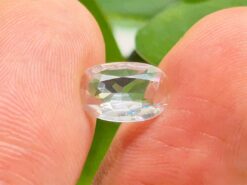Scapolite

Scapolite stone. Yellow, colorless, blue or purple scapolite gemstone.
Buy natural scapolite in our shop
The scapolites are a group of rock-forming silicate minerals composed of aluminium, calcium, and sodium silicate with chlorine, also carbonate and sulfate. The two endmembers are meionite and also marialite. Silvialite is also a recognized member of the group.
Properties
The group is an isomorphous mixture of the meionite and also marialite endmembers. The tetragonal crystals are hemihedral with parallel faces, like scheelite. And at times of considerable size. They are distinct and usually have the form of square columns.
Furthermore, some cleavages parallel to the prism-faces. Crystals are usually white or also greyish-white and opaque. We found meionite as colorless glassy crystals in the limestone blocks of Monte Somma, Vesuvius. The hardness is 5 – 6. Also the specific gravity varies with the chemical composition between 2.7 (meionite) and 2.5 (marialite).
Natural yellow, colorless, blue or purple scapolite stones are especially liable to alteration by weathering processes. With the development of mica, also kaolin, etc. Because of the usual opacity of the crystals. Owing to this alteration. and also to the variations in composition. Numerous varieties have been distinguished by special names.
The stone is commonly a mineral of metamorphic origin. It occurs usually in crystalline marbles. But also with pyroxene in schists and gneisses. The long slender prisms abundant in the crystalline marbles. Furthermore, schists in the Pyrenees are known as dipyre or also couzeranite.
Large crystals (wernerite) are found in the apatite deposits. In the neighborhood of Bamble near Brevik in Norway. It finally results from the alteration of the plagioclase of a gabbro.
Four groups
According to their genesis the rocks fall naturally into four groups:
- Limestones
Limestones and contact metamorphic rocks
As silicates rich in calcium, it is to be expected that these minerals will be found where impure limestones have been crystallized by contact with an igneous magma. - Mafic igneous rock
In many mafic igneous rocks, sapolite replaces feldspar by a secondary or metasomatic process. - Hornblende rocks
The white spots being entirely while the dark matrix enveloping them is an aggregate of green or brownish hornblende. - Metamorphic rocks of gneissose character
the white spots being entirely while the dark matrix enveloping them is an aggregate of green or brownish hornblende.
Scapolite meaning and healing properties benefits
The following section is pseudo scientific and based on cultural beliefs.
The gemstone has a meaning and properties of bringing back daily life. People believe that it has the power to fix disordered energy. You can become calmer by healing your stress. The stone is also used to improve bad habits. It can break toxic habits like smoking, gambling, or overeating.
FAQ
What is scapolite used for?
The stone is used mainly a collector and hobbyist gemstone, especially in its yellow and purple colors. Cat’s eye scapolites are also used as minor gemstones and cut into cabochons. The opaque yellow fluorescent variety described above is occasionally also used as a gemstone and mostly cut into cabochons.
Where is blue scapolite found?
Yellow, colorless, blue or purple scapolite is found in the marble region of Mogok, Myanmar, and transparent yellows crystals come from Tanzania in the Merelani Hills, Arusha; and in Morogoro, Uruguru.
Can scapolite be heat treated?
It is not typically treated or enhanced in any way, but some lavender colored stones have been known to be heat treated or irradiated. Treated stones are known to fade with exposure to heat and light.
Scapolite under microscope
Natural scapolite for sale in our gem shop
We make custom made scapolite jewelry as engagement rings, necklaces, stud earrings, bracelets, pendants… Please contact us for a quote.






